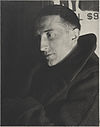Anemic Cinema
| Anemic Cinema | |
|---|---|
| French | Anémic Cinéma |
| Directed by | Marcel Duchamp |
Release date |
|
Running time | 7 minutes |
| Country | France |
Anemic Cinema or Anémic Cinéma is a 1926 Dada/surrealist French experimental film by Marcel Duchamp (credited to his alter ego, Rrose Sélavy), made in collaboration with Man Ray and Marc Allégret.
The seven-minute film is composed of alternating static camera shots of spinning animated drawings disks — which Duchamp called Rotoreliefs — inscribed with puns and alliterations in French. The text, which spirals in a counterclockwise motion, suggests erotic scenarios and the words, if read aloud, produce repetitive patterns of sounds that lead to scatological or obscene associations in reference to pulsating human sexual activity.[1] To make Anémic Cinéma, Duchamp filmed painted designs he made on flat cardboard circles while they spun on a phonograph turntable. When spinning, the flat disks appeared three-dimensional.[2]
The film premiered in a private screening in Paris in August 1926 and was acquired by MoMA in 1938, the first Duchamp work to enter a museum.
Duchamp had a commercial printer run off 500 sets of six of the designs and set up a booth at a 1935 Paris inventors' show to sell them. The venture was a financial disaster, but some optical scientists thought they might be of use in restoring three-dimensional sight to people with one eye.[3]
History
[edit]
Duchamp first showed Anemic Cinema at a private screening for friends in Paris on August 30, 1926.[4] He brought the film on a trip to New York later that year, where he held another private screening at the Fifth Avenue Playhouse on December 22, 1926, and another at Miles Studio in early 1927.[5]
Artist Hans Richter acquired a print of the film and gave it its public debut in 1929, screening it at the Film und Foto exhibition in Stuttgart.[6] New York art dealer Julien Levy obtained another print and screened it at his gallery in 1936 and 1937.[7] The Museum of Modern Art (MoMA) acquired a print from Duchamp in 1938; this was the first of Duchamp's works to enter a museum collection.[8]
The film gained recognition in the 1930s and 1940s as Richter's copy circulated to film clubs in Europe, and MoMA's copy was lent to museums and universities around North America.[9]
Rotoreliefs texts
[edit]The texts on the Rotoreliefs, in French, are the following:
- "Bains de gros thé pour grains de beauté sans trop de bengué." (Bengay was a French analgesic rub invented by Dr. Jules Bengué)
- "L'enfant qui tète est un souffleur de chair chaude et n'aime pas le chou-fleur de serre-chaude."
- "Si je te donne un sou, me donneras-tu une paire de ciseaux ?"
- "On demande des moustiques domestiques (demi-stock) pour la cure d'azote sur la Côte d'Azur."
- "Inceste ou passion de famille, à coups trop tirés."
- "Esquivons les ecchymoses des Esquimaux aux mots exquis."
- "Avez-vous déjà mis la moëlle de l'épée dans le poêle de l'aimée ?"
- "Parmi nos articles de quincaillerie paresseuse, nous recommandons le robinet qui s'arrête de couler quand on ne l'écoute pas."
- "L'aspirant habite Javel et moi j'avais l'habite en spirale."
See also
[edit]Notes and references
[edit]- Notes
- ^ Affron, Mathew. The Essential Duchamp, Yale University Press (2018), p. 85
- ^ "Marcel Duchamp's Rotoreliefs". The Guggenheim Museums and Foundation. Retrieved 9 September 2023.
- ^ Calvin Tomkins, Duchamp: A Biography (1996), pages 301–303.
- ^ Kauffman 2017a, p. 130, Note 9.
- ^ Kauffman 2017a, pp. 130–131, Note 9.
- ^ Kauffman 2017b, p. 214.
- ^ Kauffman 2017b, p. 215.
- ^ Kauffman 2017a, p. 131.
- ^ Kauffman 2017b, p. 215-216.
- References
- Kauffman, Alexander (2017a). "The Anemic Cinemas of Marcel Duchamp". The Art Bulletin. 99 (1): 128–159. doi:10.1080/00043079.2017.1249255. JSTOR 44973139.
- Kauffman, Alexander (2017b). "Faire Un Cinéma": Marcel Duchamp And The Moving Image (PhD). University of Pennsylvania. Retrieved 17 September 2022.
External links
[edit]- Anémic Cinéma at IMDB
- Anémic Cinéma film at Ubuweb
- [1] Animated display of Duchamp's Rotoreliefs at Aqualoop


 French
French Deutsch
Deutsch